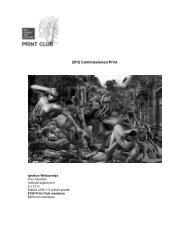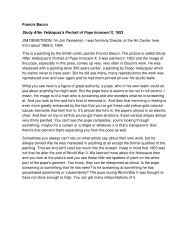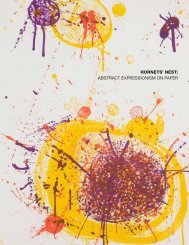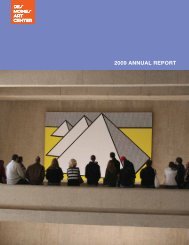Igor BegeLman wITh PhoeBuS Three - Des Moines Art Center
Igor BegeLman wITh PhoeBuS Three - Des Moines Art Center
Igor BegeLman wITh PhoeBuS Three - Des Moines Art Center
You also want an ePaper? Increase the reach of your titles
YUMPU automatically turns print PDFs into web optimized ePapers that Google loves.
2011 | 2012 SeaSon<br />
at the ar t <strong>Center</strong><br />
on stage<br />
Bold-Brilliant-Beautiful<br />
<strong>Igor</strong> Begelman | clarinet<br />
with<br />
Phoebus <strong>Three</strong><br />
SaTurday, aPrIL 21, 2012 | 8 Pm<br />
deS moIneS arT cenTer | LevITT audITorIum
Program <strong>Igor</strong> <strong>BegeLman</strong> <strong>wITh</strong> <strong>PhoeBuS</strong> <strong>Three</strong><br />
<strong>Igor</strong> Begelman | clarinet<br />
with Phoebus <strong>Three</strong><br />
<strong>Igor</strong> Begelman | clarinet Larisa Gelman | bassoon Rieko Aizawa | piano<br />
PROGRAM<br />
Trio Pathetique in D minor Mikhail Glinka (1804–1857)<br />
Allegro Moderato<br />
Scherzo: Vivacissimo<br />
Largo<br />
Allegro con spirito<br />
Histoires for piano solo Jacques Ibert (1890– 1962)<br />
La marchande d’eau fraiche (The Fresh Water Seller)<br />
La cage de cristal (The Crystal Cage)<br />
Le petit ane blanc (The Little White Donkey)<br />
La meneuse de tortues d’or (The Leader of the Golden Tortoises)<br />
Suite from Porgy and Bess George Gershwin (1898 – 1937)<br />
(arranged for clarinet and piano) Jascha Heifetz (1901 – 1987)<br />
INTERMISSION<br />
Afro for clarinet, bassoon, and piano Paquito D’Rivera (b. 1948)<br />
Romance for bassoon and piano Edward Elgar (1857 – 1934)<br />
Selections for clarinet and bassoon<br />
Los Tres Golpes Ignacio Cervantes (1847 – 1905)<br />
Ave Maria J. S. Bach (1685 – 1750) / Charles Gounod (1818 – 1893)<br />
Benny’s Gig Morton Gould (1913 – 1996)<br />
Concert Piece No. 2 in D minor Felix Mendelssohn (1809 – 1847)<br />
for clarinet, bassoon, and piano
IGOR BEGELMAN | clarinet<br />
Biography <strong>Igor</strong> <strong>BegeLman</strong> <strong>wITh</strong> <strong>PhoeBuS</strong> <strong>Three</strong><br />
In performing an astonishingly large and varied repertoire,<br />
clarinetist <strong>Igor</strong> Begelman’s virtuosity and imagination have<br />
been praised by critics as a “remarkable display of music<br />
making” and have earned him an impressive list of awards,<br />
engagements, and honors. Whether in collaboration with<br />
such distinguished artists as Richard Goode and Midori,<br />
or with such esteemed ensembles as the Chamber Music<br />
Society of Lincoln <strong>Center</strong>, <strong>Igor</strong> Begelman’s musical gifts<br />
and technical prowess take center stage.<br />
Crafting a career of international dimensions,<br />
<strong>Igor</strong> Begelman has appeared as soloist with major<br />
orchestras in the United States and abroad, including the<br />
Houston Symphony, L’Orchestre de la Suisse Romande,<br />
the Orchestra of St. Luke’s, and I Musici de Montréal<br />
among many others. His recital appearances have included<br />
engagements throughout Europe, Canada, Mexico, Japan,<br />
and Israel, as well as recitals in such distinguished venues as<br />
Philadelphia’s Kimmel <strong>Center</strong>, Boston’s Faneuil Hall,<br />
New York’s Weill Recital Hall at Carnegie, Lincoln <strong>Center</strong>,<br />
and 92nd Street Y. Equally accomplished as soloist and<br />
chamber musician, his appearances have taken him to<br />
the Caramoor and Ravinia, Marlboro, Tanglewood, and<br />
Schleswig-Holstein festivals.<br />
An active educator, Mr. Begelman has given master<br />
classes throughout the United States. He is professor of<br />
clarinet at the North Carolina School of the <strong>Art</strong>s and<br />
director of the Wind Program at the Bowdoin International<br />
Music Festival, while currently teaching at Brooklyn<br />
College and Sarah Lawrence College. Raised in Kiev,<br />
Ukraine, <strong>Igor</strong> Begelman received his master’s degree from<br />
The Juilliard School of Music and his bachelor’s degree<br />
from The Manhattan School of Music.<br />
LARISA GELMAN | bassoon<br />
Bassoonist Larisa Gelman has established herself as an<br />
exceptional and dynamic performer in the United States<br />
and abroad. In recent seasons she was featured as a<br />
soloist with the Brooklyn Symphony performing Richard<br />
Strauss’ “Duo Concertante,” and with the Broadway<br />
Bach Ensemble performing Vivaldi and Weber concertos.<br />
Ms. Gelman’s solo concerts have included Carnival in<br />
Caroline, Maryland; Impromptu Concerts, Key West,<br />
Florida; Mozart Festival at World Bank, Washington,<br />
D.C.; Kimmel <strong>Center</strong>, Philadelphia, Pennsylvania; West<br />
Chester University, Pennsylvania; Queens College, New<br />
York City; the Flint Institute of <strong>Art</strong>, Flint, Michigan;<br />
Juneau Jazz and Classics in Juneau, Alaska; The Encore<br />
Programs at Elmira College, New York; as well as the<br />
acclaimed recital at Caramoor Festival. Currently director<br />
of Educational Outreach at the 92nd Street Y, Ms. Gelman<br />
is involved with educational events in the United States by<br />
collaborating with the Midori and Friends Foundation, the<br />
New York Philharmonic Outreach Program, Astral <strong>Art</strong>istic<br />
Services, Piatigorsky Foundation and Young Audiences<br />
of New York, and abroad at the Oberlin Panama Project<br />
and the Carvalho International Music Festival and School<br />
in Brazil. Her innovative methods bring interdisciplinary<br />
involvement of music into the academic classroom.<br />
RIEKO AIZAWA | piano<br />
In 1988, Ms. Aizawa was brought to the attention of<br />
Alexander Schneider by the recommendation of pianist<br />
Mitsuko Uchida. Schneider engaged her as soloist with<br />
his Brandenburg Ensemble at the opening concerts of<br />
Tokyo’s Casals Hall; later that year, Schneider presented<br />
14-year-old Ms. Aizawa in her U.S. debut concerts at the<br />
Kennedy <strong>Center</strong> and Carnegie Hall, performing Mozart’s<br />
Concerto No. 12 in A major, K. 414, with his New York<br />
String Orchestra. The Washington Post celebrated her<br />
performance: “She played with a beautiful, limpid tone<br />
and a sense of characterization and cohesiveness that is<br />
unusual.” To complete her triumphant season of<br />
U.S. debuts, during January of 1989, Ms. Aizawa stepped<br />
in as soloist with the San Francisco Symphony, guest<br />
conducted by Schneider.
Program Notes <strong>Igor</strong> <strong>BegeLman</strong> <strong>wITh</strong> <strong>PhoeBuS</strong> <strong>Three</strong><br />
Since then Ms. Aizawa has performed in solo and<br />
orchestral engagements throughout the U.S., Canada, and<br />
Europe, including Lincoln <strong>Center</strong>’s Avery Fisher Hall,<br />
Boston’s Symphony Hall, and Chicago’s Orchestra Hall.<br />
Highlights of recent seasons have included acclaimed<br />
performances with the New Japan Philharmonic under<br />
Seiji Ozawa, the English Chamber Orchestra under Heinz<br />
Holliger, the Festival Strings Lucerne in Switzerland under<br />
Rudolf Baumgartner, the St. Paul Chamber Orchestra<br />
under Hugh Wolff, the Curtis Institute Orchestra with<br />
Peter Oundjian, the St. Louis Symphony under David<br />
Loebel, and, most recently, a wonderfully received<br />
performance with the Vienna Chamber Orchestra.<br />
As a recitalist, Ms. Aizawa has been heard in many<br />
North American cities, including New York, Philadelphia,<br />
Washington D.C., St. Louis, Seattle, Boulder, Los Angeles,<br />
Houston, and Toronto; at the Caramoor International<br />
Festival; at Lincoln <strong>Center</strong>’s Mostly Mozart Festival;<br />
Ravinia Festival; and Gilmore Keyboard Festival. Following<br />
a recent all-Beethoven recital in Dresden, Germany, a<br />
reviewer wrote: “Her listeners followed her playing—full of<br />
details and delicate contrasts—breathlessly.”<br />
Ms. Aizawa received her master’s degree from<br />
The Juilliard School of Music, where she worked with<br />
Peter Serkin. She is also a graduate of the Curtis Institute<br />
of Music in Philadelphia, where she was awarded the<br />
prestigious Rachmaninoff Prize and studied with Seymour<br />
Lipkin, Peter Serkin, and Mieczyslaw Horszowski as<br />
his last pupil.<br />
MIKHAIL GLINKA (1804 – 1857)<br />
Trio Pathetique in D minor<br />
Mikhail Glinka was the first in Russia to create romances,<br />
operas, and chamber music based on Russian themes, using<br />
Russian folk melodies, and is commonly regarded as the<br />
founder of Russian nationalism in music. His influence<br />
on composers such as Rimsky-Korsakov, Borodin, and<br />
Mussorgsky was considerable. As a child, he took some<br />
lessons with the famous Irish virtuoso pianist John Field,<br />
who was living in Petersburg, but his association with music<br />
remained purely amateur until visits to Europe which began<br />
in 1830. In both Italy and Germany he was able to formally<br />
study and improve his compositional technique. His music<br />
offered a synthesis of Western operatic form with Russian<br />
melody, while his instrumental music was a combination of<br />
the traditional and the exotic.<br />
The Trio Pathetique dates from around 1827 – 8, well<br />
after his piano studies with Field but before he embarked<br />
on his travels. It was originally for the combination of<br />
clarinet, bassoon, and piano, but Glinka’s publisher insisted<br />
he also make a version for standard piano trio, which he<br />
did. One can hear Russian folk melody, which he must<br />
have heard from the serf musicians of his uncle’s orchestra;<br />
however, it is expressed in the idiom of the Viennese classics.<br />
The opening Allegro moderato is in the transitional style<br />
of early Romanticism with a classical structure. In the<br />
second movement, Scherzo, the piano is given a sparkling<br />
part against which the others have long-breathed lyrical<br />
passages. The tuneful trio recalls early Beethoven. The trio’s<br />
center of gravity is its third movement, Largo. The sobriquet<br />
“pathetique” no doubt comes from the melodies given to<br />
the winds, especially the lower voice. The running triplets<br />
which characterize the exciting finale, Allegro con spirito,<br />
eventually give way to what must be the original basis of the<br />
thrilling movie music used in silent films.<br />
JACQUES IBERT (1890 – 1962)<br />
Histoires for piano solo<br />
Jacques Ibert was born in Paris, studied music from an early<br />
age at the Paris Conservatory, and won its top prize at his<br />
first attempt, the Prix de Rome, despite studies interrupted<br />
by his service in World War I. Before attaining success as<br />
a composer, he earned a living as a private teacher, as an<br />
accompanist, and as a cinema pianist. He took private<br />
lessons in orchestration, along with fellow students <strong>Art</strong>hur<br />
Honegger and Darius Milhaud.<br />
In addition to composing, Ibert was active as a<br />
conductor and in musical administration. In 1937 he was
Program Notes <strong>Igor</strong> <strong>BegeLman</strong> <strong>wITh</strong> <strong>PhoeBuS</strong> <strong>Three</strong><br />
appointed director of the Academie de France at the Villa<br />
Medici in Rome, and held that post until 1960, except<br />
for an enforced break during the war years of World War<br />
II. The war years were difficult for Ibert; in 1940 the<br />
Vichy government banned his music and he retreated to<br />
Switzerland. In August 1944, he was readmitted to the<br />
musical life of the country when General de Gaulle recalled<br />
him to Paris.<br />
For the theatre and cinema, Ibert was a prolific<br />
composer of incidental music. He wrote the music for more<br />
than a dozen French films, and for American directors he<br />
composed a score for Orson Welles’ 1948 film of Macbeth,<br />
and the Circus ballet for Gene Kelly’s Invitation to the<br />
Dance in 1952.<br />
GEORGE GERSHWIN (1898 – 1937)<br />
Porgy and Bess<br />
In a career tragically cut short in mid-stride by a brain<br />
tumor, George Gershwin proved himself to be not only<br />
one of the great songwriters of his extremely rich era, but<br />
also a gifted “serious” composer who bridged the worlds<br />
of classical and popular music. The latter is all the more<br />
striking, given that, of his contemporaries, Gershwin was<br />
most influenced by such styles as jazz and blues. Gershwin’s<br />
first hit, interpolated into the show Sinbad in 1919, was<br />
“Swanee,” sung by Al Jolson. Gershwin wrote both<br />
complete scores and songs for such variety shows as George<br />
White’s Scandals (whose annual editions thus were able to<br />
introduce such songs as “I’ll Build a Stairway to Paradise”<br />
and “Somebody Loves Me”). After 1924, Gershwin<br />
worked primarily with his brother Ira as his lyricist. The<br />
two scored a series of Broadway hits in the 20s and early<br />
30s, starting with “Lady Be Good” (1924), which included<br />
the song “Fascinatin’ Rhythm.” In the same year George<br />
composed his first classical piece, “Rhapsody in Blue,” and<br />
he would continue to work in the classical field until his<br />
death. By the 30s the Gershwins had turned to political<br />
topics and satire in response to the onset of the Depression,<br />
and their Of Thee I Sing became the first musical to win<br />
a Pulitzer Prize. In the mid 30s, Gershwin ambitiously<br />
worked to meld his show music and classical leanings in<br />
the creation of the folk opera Porgy and Bess, with lyrics<br />
by Ira and DuBose Heyward. The Gershwins had moved to<br />
Hollywood and were engaged in several movie projects at<br />
the time of George Gershwin’s death.<br />
THE OPERA<br />
George Gershwin’s opera, Porgy and Bess, was based on<br />
DuBose Heyward’s novel “Porgy,” and subsequent play<br />
of the same title, which he wrote with his wife Dorothy<br />
Heyward. All three works deal with African-American life<br />
in the fictitious Catfish Row (based on the area of Cabbage<br />
Row), in Charleston, South Carolina, in the early 1920s.<br />
Originally conceived as an “American folk opera,”<br />
Porgy and Bess premiered in New York in the fall of 1935,<br />
and featured an entire cast of classically trained African-<br />
American singers—a daring artistic choice at the time.<br />
Gershwin chose the African-American musician Eva Jessye<br />
as the choral director for the opera.<br />
The work was not widely accepted in the United States<br />
as a legitimate opera until 1976, when the Houston Grand<br />
Opera production of Gershwin’s complete score established<br />
it as an artistic triumph. Nine years later, the Metropolitan<br />
Opera of New York gave their first performance of the<br />
work. This production was also broadcast as part of the<br />
ongoing Saturday afternoon live Metropolitan Opera<br />
radio broadcasts. The work is now considered part of the<br />
standard operatic repertoire and is regularly performed<br />
internationally. <strong>Des</strong>pite this success, the opera has been<br />
controversial; some critics from the outset have considered<br />
it a racist portrayal of African-Americans.<br />
JASCHA HEIFETZ (1901 – 1987)<br />
More than a century after his public debut, the name Jascha<br />
Heifetz continues to evoke awe and excitement among<br />
fellow musicians. In a performing career that spanned<br />
65 years, he established an unparalleled standard of violin<br />
playing to which violinists around the world still aspire.<br />
After the 19-year-old Heifetz’s London debut, George<br />
Bernard Shaw wrote him a now legendary letter. “If you<br />
provoke a jealous God by playing with such superhuman<br />
perfection,” Shaw warned, “you will die young. I earnestly<br />
advise you to play something badly every night before going<br />
to bed, instead of saying your prayers. No mortal should<br />
presume to play so faultlessly.”<br />
Heifetz is widely considered to be one of the most<br />
profoundly influential performing artists of all time. Born<br />
in Vilna, Russia on February 2, 1901, he became a U.S.<br />
citizen in 1925. Fiercely patriotic to his adopted country,<br />
he gave hundreds of concerts for Allied service men and<br />
women during World War II, including tours of Central<br />
and South America, North Africa, Italy, France, and<br />
Germany, often playing from the back of a flatbed truck<br />
in dangerous conditions.
Program Notes <strong>Igor</strong> <strong>BegeLman</strong> <strong>wITh</strong> <strong>PhoeBuS</strong> <strong>Three</strong><br />
In 1928, he published the first of dozens of acclaimed<br />
violin transcriptions. Many, including his arrangements of<br />
selections from Gershwin’s “Porgy and Bess,” are now part<br />
of the standard repertoire. Using the pseudonym Jim Hoyl,<br />
he even wrote a pop song that became a hit in 1946.<br />
In his later years, Heifetz became a dedicated teacher<br />
and a champion of causes he believed in. He led efforts<br />
to establish “911” as an emergency phone number, and<br />
crusaded for clean air. He and his students at the University<br />
of Southern California protested smog by wearing gas<br />
masks, and in 1967 he converted his Renault passenger car<br />
into an electric vehicle.<br />
As a result of his vast recorded legacy, Heifetz’s violin<br />
playing is no less influential today than it was in his<br />
lifetime. To legions of violinists he remains, quite simply,<br />
“The King.”<br />
PAQUITO D’RIVERA (b. 1948)<br />
Afro for clarinet, bassoon, and piano<br />
Born on the island of Cuba, Paquito D’Rivera began his<br />
career as a child prodigy. A restless musical genius during<br />
his teen years, Mr. D’Rivera created various original and<br />
groundbreaking musical ensembles. As a founding member<br />
of the Orquesta Cubana de Musica Moderna, he directed<br />
that group for two years, while at the same time playing<br />
both the clarinet and saxophone with the Cuban National<br />
Symphony Orchestra. He eventually went on to premiere<br />
several works by notable Cuban composers with the same<br />
orchestra. Additionally, he was a founding member and codirector<br />
of the innovative musical ensemble Irakere. With<br />
its explosive mixture of jazz, rock, classical, and traditional<br />
Cuban music never before heard, Irakere toured extensively<br />
throughout America and Europe, won two Grammy<br />
nominations (1979, 1980) and a Grammy (1979).<br />
Paquito D’Rivera’s first recognition as a solo artist<br />
by The Recording Academy (GRAMMYs) came in 1996<br />
with the highly acclaimed recording Portraits of Cuba.<br />
Since then, Mr. D’Rivera has received many recognitions<br />
as an artist and composer, including two nominations for<br />
his recent release, JazzClazz (featuring Sabine Meyer and<br />
Trio Clarone). In addition to his extraordinary performing<br />
career as an instrumentalist, Paquito D’Rivera has rapidly<br />
gained a reputation as a dynamic composer. His works<br />
often reveal his widespread and eclectic musical interests,<br />
ranging from Afro-Cuban rhythms and melodies, including<br />
influences encountered in his many travels, and back to his<br />
classical origins<br />
EDWARD ELGAR (1857 – 1934)<br />
Romance for bassoon and piano<br />
Sir Edward Elgar was born on June 2, 1857 at Broadheath,<br />
a village some three miles from the small city of Worcester<br />
in the English West Midlands. His father had a music<br />
shop in Worcester and tuned pianos. The young Elgar,<br />
therefore, had the great advantage of growing up in a<br />
thoroughly practical musical atmosphere. He studied the<br />
music available in his father’s shop and taught himself to<br />
play a wide variety of instruments. It is a remarkable fact<br />
that Elgar was very largely self-taught as a composer—<br />
evidence of the strong determination behind his original<br />
and unique genius. His long struggle to establish himself<br />
as a pre-eminent composer of international repute was<br />
hard and often bitter. For many years he had to contend<br />
with apathy, with the prejudices of the entrenched musical<br />
establishment, with religious bigotry (he was a member<br />
of the Roman Catholic minority in a Protestant majority<br />
England), and with a late Victorian provincial society<br />
where class consciousness pervaded everything.<br />
Through the 1880s and the 1890s Elgar’s experience<br />
grew and his style matured as he conducted and composed<br />
for local music organizations. He also taught violin and<br />
played the organ at St. George’s Roman Catholic Church in<br />
Worcester. In 1889 he married one of his pupils, Caroline<br />
Alice Roberts, daughter of the late Major-General Sir<br />
Henry Roberts, who had enjoyed a distinguished career<br />
with the British army in India. She married Edward in<br />
opposition to her family, who considered that in marrying<br />
the son of a mere tradesman, a music teacher without<br />
prospects, she was marrying beneath herself. Nevertheless,<br />
Alice, with determination and a dogged faith in Edward’s<br />
emerging genius, played a vital part in the development<br />
of his career. That faith was rewarded in 1904, when<br />
an all-Elgar festival was held at Covent Garden, and the<br />
composer was knighted by King Edward VII.<br />
IGNACIO CERVANTES (1847 – 1905)<br />
Los Tres Golpes<br />
Ignacio Cervantes was a Cuban virtuoso pianist and<br />
composer, enormously influential in the creolization of<br />
Cuban music. A child prodigy, he was taught by pianist<br />
Juan Miguel Joval, later by composer and tutor Nicolas<br />
Ruiz Espadera in 1859, and by the visiting American<br />
composer Louis Moreau Gottschalk. Gottschalk<br />
encouraged Cervantes to study at the Conservatoire de<br />
Paris, which he did from 1866–1870 under Antoine<br />
François Marmontel and Charles-Valentin Alkan, and was<br />
awarded first prizes in composition (1866) and harmony
Program Notes <strong>Igor</strong> <strong>BegeLman</strong> <strong>wITh</strong> <strong>PhoeBuS</strong> <strong>Three</strong><br />
(1867). He also performed with Christina Nilsson and<br />
Adelina Patti.<br />
In 1875 Cervantes and Jose White left Cuba when<br />
warned by the governor-general, as he had found out that<br />
they had been giving concerts all over the country to raise<br />
money for the rebel cause in the Ten Years’ War. In the<br />
U.S. and Mexico, Cervantes continued to raise money by<br />
giving concerts until the pact of Zanjon brought a lull in the<br />
conflict. He returned in 1878 and left again in 1895 when<br />
the Cuban War of Independence started.<br />
Cervantes wrote one opera (Maledetto, 1895), various<br />
chamber pieces, “Scherzo capriccioso,” 1885, “Zarzuelas,”<br />
and the famous forty-one “Danzas Cubanas.” He also<br />
conducted for the opera company at Havana’s Payret<br />
Theater. His “Fusion de Almas” was written for his daughter,<br />
Maria Cervantes (1885 – 1981), who became a well-known<br />
pianist, composer, and singer.<br />
J. S. BACH (1685 – 1750)<br />
CHARLES GOUNOD (1818 – 1893)<br />
Ave Maria<br />
Charles Gounod was born in Paris, the son of a pianist<br />
mother and an artist father. His mother was his first piano<br />
teacher, but he ultimately entered the Paris Conservatory<br />
and studied with Fromental Halevy. In 1839 he won the<br />
Prix de Rome, and while in Italy studied the music of<br />
Palestrina and other sacred works of the sixteenth century.<br />
These he never ceased to cherish. An 1855 performance of<br />
Gounod’s Saint Cecilia Mass was very well received, and<br />
dates his fame as a noteworthy composer.<br />
Fanny Mendelssohn, sister of Felix Mendelssohn,<br />
introduced the keyboard music of Johann Sebastian Bach<br />
to Gounod, who came to revere Bach. For him, The Well-<br />
Tempered Clavier was “the law to pianoforte study…the<br />
unquestioned textbook of musical composition.” It inspired<br />
Gounod to devise an improvisation of a melody over the<br />
C major Prelude from the collection’s first book. To this<br />
melody, Gounod fitted the words of the Ave Maria, resulting<br />
in a setting that became world famous.<br />
Gounod wrote his first opera, Sapho, in 1851, but it<br />
was a commercial failure. He had no great theatrical success<br />
until Faust (1859), derived from Goethe. This remains the<br />
composition for which he is best known; and although it<br />
took a while to achieve popularity, it became one of the<br />
most frequently staged operas of all time, with no fewer<br />
than 2,000 performances of the work having taken place by<br />
1975 at the Paris Opera alone, not counting other theaters.<br />
MORTON GOULD (1913 – 1996)<br />
Benny’s Gig<br />
Morton Gould was an American composer, conductor,<br />
arranger, and pianist. Born in Richmond Hill, New<br />
York, Gould was recognized early as a child prodigy<br />
with abilities in improvisation and composition. His first<br />
composition was published at age six. Gould studied at<br />
the Institute of Musical <strong>Art</strong>, although his most important<br />
teachers were Abby Whiteside and Vincent Jones.<br />
During the Depression, Gould, while a teenager,<br />
worked in New York City playing piano in movie theaters<br />
as well as with vaudeville acts. When Radio City Music Hall<br />
opened, Gould was hired as the staff pianist. By 1935, he was<br />
conducting and arranging orchestral programs for New York’s<br />
WOR radio station, where he reached a national audience<br />
via the Mutual Broadcasting System, combining popular<br />
programming with classical music.<br />
In the 1940s Gould appeared on the Cresta Blanca<br />
Carnival program as well as The Chrysler Hour where<br />
he reached an audience of millions. He composed<br />
Broadway scores, film music, music for television series,<br />
and ballet scores. Gould’s music, commissioned by<br />
symphony orchestras all over the United States, was also<br />
commissioned by the Library of Congress, The Chamber<br />
Music Society of Lincoln <strong>Center</strong>, the American Ballet<br />
Theatre, and the New York City Ballet.<br />
As a conductor, Gould led all of the major American<br />
orchestras as well as those of Canada, Mexico, Europe,<br />
Japan, and Australia. With his orchestra, he recorded<br />
music of many classical standards, including Gershwin’s<br />
“Rhapsody in Blue”on which he also played the piano.<br />
Incorporating new styles into his repertoire as they<br />
emerged, Gould integrated wildly disparate elements,<br />
including a rapping narrator and a singing fire department<br />
into commissions for the Pittsburgh Youth Symphony. In<br />
1993, his work “Ghost Waltzes” was commissioned for<br />
the ninth Van Cliburn International Piano Competition.<br />
In 1994, Gould received a Kennedy <strong>Center</strong> Honor in<br />
recognition of lifetime contributions to American culture.<br />
FELIX MENDELSSOHN (1809 – 1847)<br />
Concert Piece No. 2 in D minor for clarinet, bassoon,<br />
and piano<br />
Felix Mendelssohn, grandson of the distinguished Jewish<br />
thinker, Moses Mendelssohn, was born in Hamburg, the<br />
son of a banker, (the additional surname Bartholdy was<br />
added to the family name when his parents converted<br />
to Christianity). The family moved to Berlin, where<br />
Mendelssohn was brought up, and was able to associate
with a cultured circle of friends. He was associated with the<br />
revival of public interest in the music of J. S. Bach, and in the<br />
early 1830s traveled abroad for his education, spending time<br />
in Italy and also visiting England, Wales, and Scotland.<br />
In 1829, Mendelssohn spent a very pleasant time in<br />
Munich, a city which the young composer felt had a greater<br />
hospitality and greater culture than Vienna. He saw a good<br />
deal of clarinet virtuoso Heinrich Bahrmann, becoming good<br />
friends, and wrote the Concert Piece No. 2 for Bahrmann<br />
and his son. The piece was first performed in January 1833,<br />
with Bahrmann on clarinet, his son, Carl, on basset horn, and<br />
Mendelssohn on piano.<br />
Mendelssohn became Conductor of the Gewandhaus<br />
Orchestra in Leipzig early in 1835 (where he also established<br />
a conservatory), his stay there interrupted briefly by a return<br />
to Berlin. He died in Leipzig in 1847. Prolific and precocious,<br />
Mendelssohn had many musical gifts as composer, conductor,<br />
and pianist. His style of composition combined something<br />
of the economy of means of the Classical period with the<br />
romanticism of a later age.<br />
We would like to thank each of the individuals<br />
and sponsors who have supported On Stage throughout<br />
the years, in particular Buz and Sue Brenton.<br />
Your generosity has enabled us to present a world-class<br />
concert series for 15 years. We would also like<br />
to express our sincere appreciation to Gilda Biel<br />
for her devotion to this program. Gilda’s passion and<br />
commitment is an inspiration to us all.<br />
on stage 2011–2012 is<br />
co-sponsored by<br />
Homesteaders Life Company<br />
and iles Funeral Homes.<br />
ILES FUNERAL HOMES<br />
Media support provided<br />
by iowa Public radio<br />
entirelyunexpected<br />
4700 Grand avenue des <strong>Moines</strong>, iowa 50312-2099<br />
515.277.4405 www.desmoinesartcenter.org<br />
Thank you<br />
The following people have<br />
generosly contributed to an<br />
endowment challenge grant<br />
for on Stage.<br />
Joy Harvey and Roy Adolphson<br />
Sigurd E. and Ann Anderson<br />
Anonymous<br />
Sarah Frank and Jack Balcombe<br />
Patricia S. Balcombe<br />
J.C. and Sue Brenton<br />
Susan Madorsky and Edward Bruggemann<br />
Suzanne S. Curry<br />
Donald and Marian Easter<br />
Rita Fisher<br />
Corrine and Greg Ganske<br />
Julia J. Gentleman<br />
Mary Gottschalk<br />
Karl and Barbara Gwiasda<br />
Cora Curtis Hayes<br />
R. Michael and Lorrie Hayes<br />
Lin He<br />
Sara and Luther Hill, Jr.<br />
Peggy Huppert<br />
Iowa Foundation for Education,<br />
Environment, and the <strong>Art</strong>s<br />
Michelle McGovern and Jack Janda<br />
Mertze Anderson and Wade Johnson<br />
Milan and Eileen Kaderavek<br />
Irina and Ken Kaplan<br />
Winifred M. Kelley<br />
Deanna R. Lehl<br />
Jeanne and Richard Levitt<br />
Harriet S. Macomber<br />
John and Maxine McCaw<br />
Thomas and Nancy McKlveen<br />
Mary I. Robinson<br />
Dr. Beverly Robinson<br />
Dr. and Mrs. Craig A. Shadur<br />
T. Nicholas Tormey, Ph.D.<br />
Mr. and Mrs. F.W. Weitz<br />
Jane and Roger Zobel<br />
Thank you to the following donors<br />
who have generously supported the<br />
on Stage Program from<br />
2/1/2011 – 4/15/2012.<br />
Sarah Frank and Jack Balcombe<br />
J.C. and Sue Brenton<br />
Julia B. Gentleman<br />
Cora Curtis Hayes<br />
R. Michael and Lorrie Hayes<br />
Nancy Hewitt<br />
Sara and Luther Hill<br />
Deanna R. Lehl<br />
Susan Madorsky and Edward Bruggemann<br />
Clarence Padilla<br />
Steve Rottler<br />
Mr. and Mrs. F.W. Weitz










